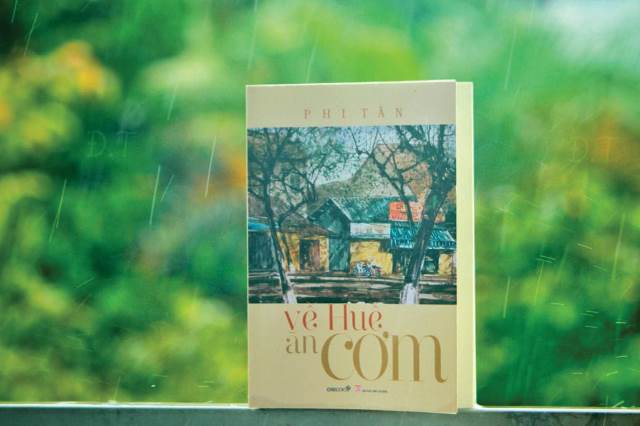I’ve got this idea in mind from my mom. To her, books are to respect and cherish. She never throws them on the floor, let alone tears, stains, or treads on them.

“Returning to Hue to Eat Rice” published in November, 2021
It is also the third book present that Phi Tan gave me. I love it so much because it is memories inside him, which are told in an innocent and charming manner. Hidden somewhere is his humor which makes me giggle.
The book makes me relate Phi Tan’s soul to a garden in the countryside, extremely rustic, pure, gentle, and modest, in which his father, his mother, and his grandparents sow seeds of generosity and honesty, and his friends and neighbors, seeds of neighborliness and friendship.
In that garden, all the trees grow happily together. I think not only Tan is lucky to grow up in that garden, but each of us, readers, when reading Phi Tan’s books today, is also lucky to read beautiful pages of memories of a person with a pure kind heart.
Tan's stories remind readers like us, who were born in the 1965-1975 of the 20th century, (i.e. about 45-50 years ago,) of our youth. Back then, we lacked food and clothes, but no one was left alone. Life was hard but full of love. It was that period of time that nurtured people many of whom are now mature and successful. Phi Tan is one of them.
The foods in “Returning to Hue to Eat Rice” which Phi Tan invites us are cheap and popular foods in the countryside cooked by mothers. Boiled rice is eaten with fish caught from paddy fields, vegetables grown in the garden, shrimps, mussels, clams and tunas from Thuan An Sea, jellyfish from Tam Giang Lagoon. Then there are other dishes such as mixed fig, boiled sweet potato greens, water spinach salad, melon soup, fresh melon dipped in shrimp paste and spices such as chive, fragrant hot green chili, fish sauce with powered chili, etc.
I flipped back and forth the menu of dozens of dishes that Phi Tan serves in the book, but did not find any expensive and luxurious dishes. They are popular dishes which I always miss and crave, especially the ones eaten with fish sauce and chili.
I feel happy to read Tan’s “Returning to Hue to Eat Rice.” It reminds me of my beautiful childhood with dinners when my whole family gathered at the kitchen enjoying the sizzling sounds of frying and the smell of food.
I miss the fire brightening my mother’s face and our eager eyes when she brought food to the table. That fire, that atmosphere, that smell of food, that taste of fat and salty fish sauce with chili and garlic can be found not only at Phi Tan’s house, but at many others’ at the time.
Somebody told me that she was so excited about the book that she forgot about her braised fish pot on the stove until it got burnt. I believe in Phi Tan’s words and in the way he told his stories. It is not the writing style or something that interests me, but the honesty that he puts in his book does.
All types of food can be found in “Returning to Hue to Eat Rice.” Phi Tan has such good memory. He “ate to remember.” I now want to stay longer with the piece “Sweet Bowl Sugar” because I find that his mother and mine have the same way of treating their children.
At that time, my mom sold Quang Ngai bowl sugar. When making bowl sugar, people use bowls as molds and in Quang Ngai, molds are often overflown with sugar, creating extra swollen parts on the bowl sugar. I craved sugar so much that I bit all the extra parts on each sugar bowl.
Because of that, people paid my mother less for her sugar, but she never scolded me at all. “Remember not to do it again. Next time, if you feel like eating sugar, you can have a whole bowl,” she told me softly.
I have kept that lesson in mind until now and applied it in raising my children. Today on a cold rainy day, reading Phi Tan’s “Sweet Bowl Sugar,” it is as if I were reviewing my sweet memories with my mom and I feel warm in heart.
I believe readers of any ages will find at least one memory about their mothers, their family meals, or their meals with friends, or they themselves will be impressed with a certain Hue dish when they read the book simply because those dishes can be found in their mothers’ menus.
Story: Xuan An. Photo: Phi Tan